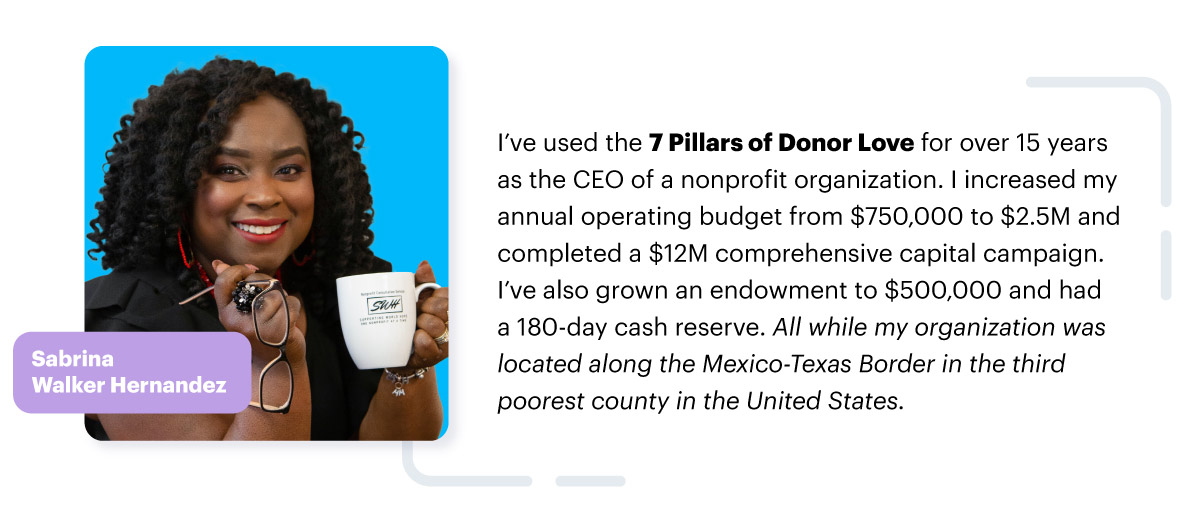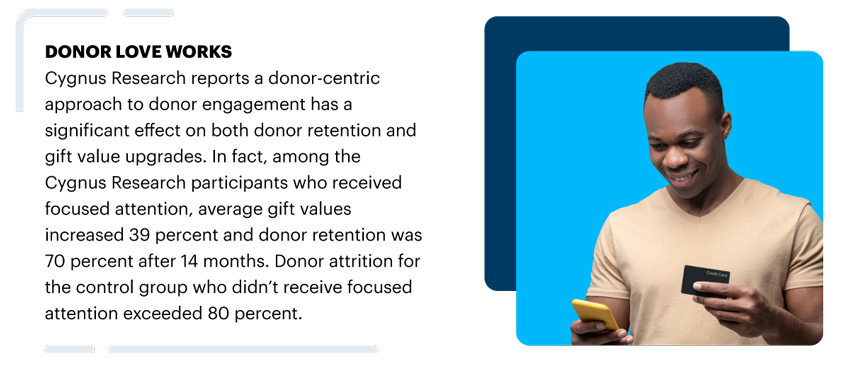Nonprofit Technology & Fundraising Blog
Subscribe to our mailing list
February 10, 2022 | Donor Engagement, Donor Retention, Thanking Donors

Submitted by Sabrina Walker Hernandez
Donor love is the key to repeat gifts. 65% of first-time donors don’t make a second gift. That’s what Penelope Burk’s donor-centered research tells us. Most studies agree that it costs nonprofits about 10 times more to bring in a new donor than to keep an existing donor. For each 100 new donors nonprofits brought in, they lost 99.
So, while nonprofits were spending time and money chasing new donors, the old ones (who were already sold on your cause and showed up to support you) walked away.

Here is the one thing I know. Donor retention must be a priority if you want to survive and thrive in today’s competitive nonprofit marketplace. Period.
No arguments or excuses.
Securing donors only to lose them is just not a good business model.
Don’t focus your message on the nonprofit. Your message should be donor-centered and satisfy the donors’ needs upfront and center. Our job as a nonprofit is to help our donors see themselves as heroes. They want to help solve a problem, allow them the opportunity to do so.
With every communication – written or verbal – make sure you are sharing the impact of your nonprofit on those you serve. These stories should inspire, re-engage, re-energize and make your donors fall in love with your nonprofit over and over again. Your client stories should provoke an emotional response in your donor.
Be patient! It is very unwise to rush this discovery process. In the donor discovery process, donors tend to talk more than the organization, development staff asks more than tell. Be careful not to talk about gift-giving opportunities until after you have uncovered what the donor wants to accomplish. The goal is to find out what’s important to donors. Focus on gathering information on your donor – or potential donor – and not on providing information without aim.
Would you ask someone to marry you upon meeting them? Probably not. Just like in fundraising, you would not ask a donor for a gift during your first meeting. It’s important to look before you leap.
Sixty percent of fundraising is cultivation. Cultivation is everything that happens between the time you identify a person as a prospective donor for your organization until the time you make the first ask.
Next, you will solicit a gift. Or, in our dating analogy, ask for their hand in marriage. Like relationships, there is no set rule on how long the cultivation phase should last. A great tip to keep in mind is the larger the ask the longer time you should spend cultivating.
And, like dating, once you are married, don’t forget to remember those special days like anniversaries and holidays. This is stewardship, saying thank you, and showing appreciation.

In your appeals, use a picture that shows one client close up. Donors will identify with that client and feel they can help fix something for them. When you share pictures of large groups, the donor gets overwhelmed and may tell themselves, “I can’t fix the problem for all those people.” When asking for money, you should ask for a specific amount. You need to make it easy and make it feel good!
You must thank your donors so that they understand the impact they’ve made on your organization. Donors need to connect to human beings because they need to feel an ongoing connection. Otherwise, they’re unlikely to repeat their gift. The more personal, the better. For example, don’t send a mass email or a holiday greeting. An often-overlooked step, stewardship (saying thank you), can pave the way for future gifts or referrals from donors. It is important that you give thanks, so donors want to give again and again.
Ongoing communication is the foundation of REAL donor love. Absence does not make the heart grow fonder. You want to avoid giving your donor the impression you don’t really care that much about them. Do you know the feeling? The one you get when friends get busy and forget to call or text? Eventually, you stop thinking about each other. The goal is to stay top of mind! You need to have an ongoing plan to communicate with your donors. At a minimum, you should send a monthly e-newsletter that shares your nonprofit impact stories. At least once a year send something by mail. It’s more personal and your donors are more likely to see it.

So, let’s start loving our existing donors and stop obsessing about strangers.
Sabrina is a certified consultant, coach, & facilitator that helps small nonprofit Staff & Board build relationships that convert into more donations. She has over 25 years of experience in nonprofit management, fundraising, and leadership. Among Sabrina’s successes is that she increased operation revenue from $750,000 to $2.5M and completed a $12M comprehensive capital campaign in the 3rd poorest county in the United States. She has facilitated numerous workshops with hundreds of nonprofit professionals. Sabrina is certified in Nonprofit Management by Harvard Business School. She is an active community leader and volunteer in Edinburg, Texas where she is based.
You can follow Sabrina on Instagram @the_nonprofitexpert and other social media platforms @supportingworldhope: Facebook, YouTube, LinkedIn, Pinterest. You can also visit my website at www.supportingworldhope.com.
Fill out the form below to get a personal demo or call 800-220-8111.
Follow us on social!